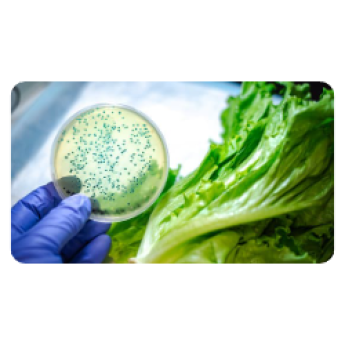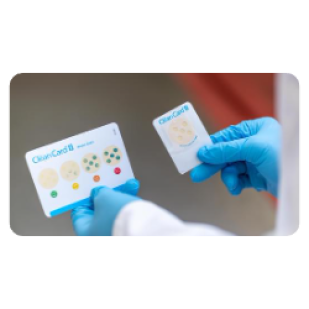Cross-contamination: This is how it can be prevented in the online trade of unpackaged goods!
Günter Dorn - Veröffentlicht am 13 March 2023
The number of orders in online retail is increasing and more and more startups offer various delivery services for unpacked food. A lack of knowledge can lead to bacteria or microorganisms being unknowingly transferred to unpackaged goods. In the worst case, this can have an impact, in the form of disease, on humans. It is therefore all the more important to comply with the necessary food hygiene regulations.
How does cross-contamination occur with food?
Cross-contamination involves the transfer of bacteria, viruses, other microorganisms and allergens from one product to another or from one surface to another. They can be transferred by direct contact via contaminated utensils, through air or liquids between different products or surfaces. In the food industry, cross-contamination can cause food to become contaminated with harmful bacteria and potentially pose a health risk.
Types of contamination
There are 3 types of contamination:
- Transmission of pathogenic (disease-causing) microorganisms: Pathogenic microorganisms are those microbes that can cause disease. They include bacteria, viruses, fungi, protozoa and other types of microorganisms. Pathogenic microorganisms can harm human health by causing infections that can cause serious diseases in humans, animals and plants.
- Transfer of allergens to a product during the production process: allergens that can be transferred to a product during the production process are: Milk, eggs, peanuts, fish, crustaceans, soy, wheat, nuts, celery and mustard.
- Contamination of the product by residues in the production plant: if a product is contaminated by residues in the production plant, this can lead to undesirable side effects. Here, this is exactly what can lead to a health hazard for consumers when the product is consumed. Likewise, the residues can affect the quality of the product and impair its function.
How do direct and indirect contamination differ?
Direct contamination is the direct transmission of pathogens from one person or object to another. Direct contamination can occur in a variety of ways, including contact, droplets, or aerosols.
Indirect contamination is the transfer of pathogens from one object to another without using a person or other object as a carrier. This can occur through contact with contaminated surfaces, objects, or materials.

What measures help prevent cross-contamination?
The need for suitable hygiene processes is clear. The two directives DIN 10543 and DIN 10508 set out the legally regulated minimum requirements for hygiene standards.
DIN 10543: This is a guideline issued by the German Chambers of Industry and Commerce (DIHK) on hygiene in the food industry. It specifies the minimum requirements for hygiene standards for the production and sale of food. These include the clean design of the workplace and mechanical equipment, regular cleaning and disinfection of work areas, control of water quality and compliance with HACCP guidelines. In addition, the guideline provides guidance on the treatment of foodstuffs to ensure a hygienically perfect end product.
DIN 10508: This is a German set of food hygiene regulations that deals with food hygiene requirements. It specifies the requirements for handling food and the associated hygiene measures. These include, for example, compliance with HACCP (Hazard Analysis and Critical Control Point) guidelines, hygiene and control measures, and certain requirements for the premises where food is produced, processed and stored.

To prevent cross-contamination of unpackaged goods in online retail, the following measures should be taken:
1. different disposable and reusable containers should be used to match the product.
2. a separate container should be used for each customer.
3. all containers and accessories must be cleaned after each use. A solution of hot water and a suitable detergent is suitable for this purpose.
4. gloves should be used when packing the product, so that contamination by human skin is prevented.
5. to prevent contamination by conventional labels, disposable adhesive tapes and labels should be used when packing the goods.
6.Use plastic film when packing food to prevent contamination by detaching materials.
7. Ensure that all containers and packaging are adequately airtight sealed. This will prevent contamination by air and moisture.
8. to prevent contamination by heat, it is essential to pay attention to the cold chain of food in need of refrigeration. Foodstuffs in particular need of refrigeration require suitable transport packaging and a refrigeration concept in line with requirements.
How can the cleanliness of a container be checked?
Containers of unpackaged goods must be spotless and clean after the cleaning and disinfection process has been completed. Visual cleanliness alone is not sufficient to detect the invisible potential for danger. This is especially true with regard to cleaning agent residues. The Clean Card is suitable for assessing the degree of cleaning. The color reactions of the Clean Card indicate the respective degree of cleaning of the containers. Further information on the Clean Card can be found here: https://g-dorn.com/de/clean-card

Gerne unterstütze ich Sie bei der Verhinderung von Kreuzkontaminationen. Auch bei der Optimierung Ihrer bestehenden Maßnahmen bin ich gerne Ihr persönlicher Ansprechpartner. Kontaktieren Sie mich, um Ihre Einsparpotenziale zu erkennen!
List of sources:
https://www.beuth.de/de/themenseiten/lebensmittelsicherheit
https://de.wikipedia.org/wiki/Kreuzkontamination
Weitere Use-Cases

„Ich bin da, wo auch immer Sie mich benötigen.“

Ich stehe Ihnen mit umfassenden branchenspezifischen Kenntnissen im Bereich der Reinigungsprozesse zur Seite.
-
Conscious sustainability in professional use02 June 2023
-
Avoiding listeria infection: where and how?20 April 2023
-
Cross-contamination: This is how it can be prevented in the online trade of unpackaged goods!13 March 2023
-
Cold chain "Quality from the beginning to consumption".30 January 2023
-
Food defense in indoor bakery16 January 2023
-
Mandatory reuse 202305 January 2023
© JD5 - Günter Dorn
Crafted with ❤ by Werwolf Media.
 English (United Kingdom)
English (United Kingdom)  Deutsch (Deutschland)
Deutsch (Deutschland)